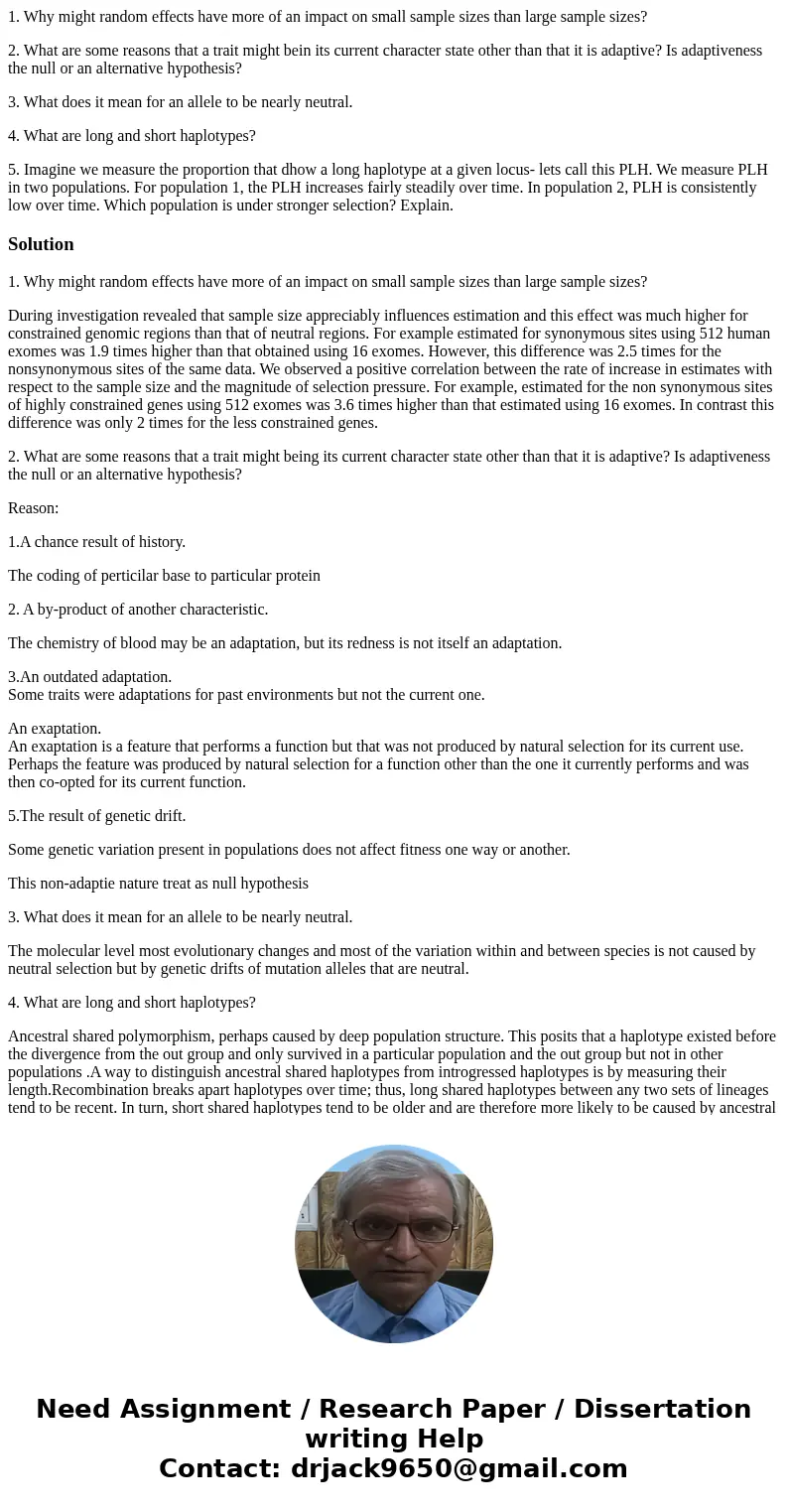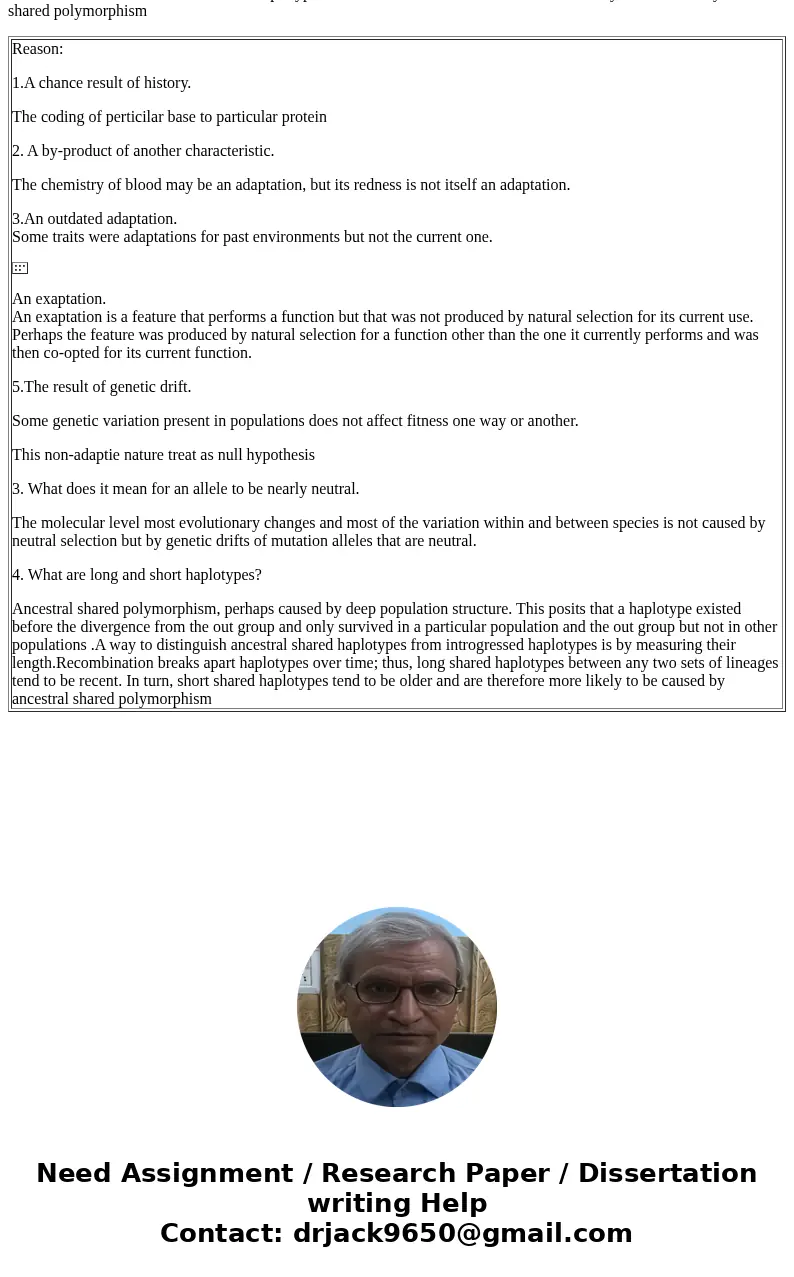1 Why might random effects have more of an impact on small s
1. Why might random effects have more of an impact on small sample sizes than large sample sizes?
2. What are some reasons that a trait might bein its current character state other than that it is adaptive? Is adaptiveness the null or an alternative hypothesis?
3. What does it mean for an allele to be nearly neutral.
4. What are long and short haplotypes?
5. Imagine we measure the proportion that dhow a long haplotype at a given locus- lets call this PLH. We measure PLH in two populations. For population 1, the PLH increases fairly steadily over time. In population 2, PLH is consistently low over time. Which population is under stronger selection? Explain.
Solution
1. Why might random effects have more of an impact on small sample sizes than large sample sizes?
During investigation revealed that sample size appreciably influences estimation and this effect was much higher for constrained genomic regions than that of neutral regions. For example estimated for synonymous sites using 512 human exomes was 1.9 times higher than that obtained using 16 exomes. However, this difference was 2.5 times for the nonsynonymous sites of the same data. We observed a positive correlation between the rate of increase in estimates with respect to the sample size and the magnitude of selection pressure. For example, estimated for the non synonymous sites of highly constrained genes using 512 exomes was 3.6 times higher than that estimated using 16 exomes. In contrast this difference was only 2 times for the less constrained genes.
2. What are some reasons that a trait might being its current character state other than that it is adaptive? Is adaptiveness the null or an alternative hypothesis?
Reason:
1.A chance result of history.
The coding of perticilar base to particular protein
2. A by-product of another characteristic.
The chemistry of blood may be an adaptation, but its redness is not itself an adaptation.
3.An outdated adaptation.
Some traits were adaptations for past environments but not the current one.
An exaptation.
An exaptation is a feature that performs a function but that was not produced by natural selection for its current use. Perhaps the feature was produced by natural selection for a function other than the one it currently performs and was then co-opted for its current function.
5.The result of genetic drift.
Some genetic variation present in populations does not affect fitness one way or another.
This non-adaptie nature treat as null hypothesis
3. What does it mean for an allele to be nearly neutral.
The molecular level most evolutionary changes and most of the variation within and between species is not caused by neutral selection but by genetic drifts of mutation alleles that are neutral.
4. What are long and short haplotypes?
Ancestral shared polymorphism, perhaps caused by deep population structure. This posits that a haplotype existed before the divergence from the out group and only survived in a particular population and the out group but not in other populations .A way to distinguish ancestral shared haplotypes from introgressed haplotypes is by measuring their length.Recombination breaks apart haplotypes over time; thus, long shared haplotypes between any two sets of lineages tend to be recent. In turn, short shared haplotypes tend to be older and are therefore more likely to be caused by ancestral shared polymorphism
| Reason: 1.A chance result of history. The coding of perticilar base to particular protein 2. A by-product of another characteristic. The chemistry of blood may be an adaptation, but its redness is not itself an adaptation. 3.An outdated adaptation. An exaptation. 5.The result of genetic drift. Some genetic variation present in populations does not affect fitness one way or another. This non-adaptie nature treat as null hypothesis 3. What does it mean for an allele to be nearly neutral. The molecular level most evolutionary changes and most of the variation within and between species is not caused by neutral selection but by genetic drifts of mutation alleles that are neutral. 4. What are long and short haplotypes? Ancestral shared polymorphism, perhaps caused by deep population structure. This posits that a haplotype existed before the divergence from the out group and only survived in a particular population and the out group but not in other populations .A way to distinguish ancestral shared haplotypes from introgressed haplotypes is by measuring their length.Recombination breaks apart haplotypes over time; thus, long shared haplotypes between any two sets of lineages tend to be recent. In turn, short shared haplotypes tend to be older and are therefore more likely to be caused by ancestral shared polymorphism |


 Homework Sourse
Homework Sourse